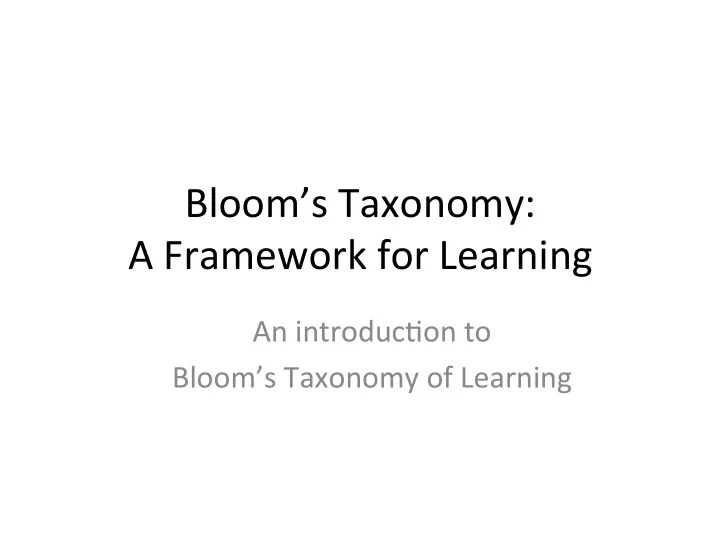

Bloom’s ¡Taxonomy: ¡ A ¡Framework ¡for ¡Learning ¡ An ¡introduc<on ¡to ¡ ¡ Bloom’s ¡Taxonomy ¡of ¡Learning ¡
Ramkhamhaeng ¡University ¡ ¡ New ¡Media ¡Repor7ng ¡(MCS ¡3271 ¡) ¡ Dr. ¡E. ¡Anthony ¡Collins, ¡Professor ¡ Web: ¡www.anthonycollinsfilm.com ¡ Email: ¡iefilm@yahoo.com ¡ ¡ Blog: ¡ anthonycollinsfilm.wordpress.com ¡ ¡
Bloom’s ¡Taxonomy: ¡ A ¡Framework ¡for ¡Learning ¡ An ¡introduc<on ¡to ¡ ¡ Bloom’s ¡Taxonomy ¡of ¡Learning ¡
What ¡is ¡Learning? ¡ What ¡is ¡knowing? ¡ How ¡can ¡I ¡ know ¡that ¡I ¡ know ¡ something? ¡
What ¡is ¡a ¡taxonomy? ¡ A ¡taxonomy ¡is ¡a ¡classifica<on ¡system ¡ used ¡to ¡define ¡and ¡dis<nguish ¡ different ¡levels ¡of ¡human ¡cogni<on— i.e., ¡thinking, ¡learning, ¡and ¡ understanding. ¡ ¡
Bloom’s ¡Taxonomy ¡of ¡Learning ¡ (1956) ¡ Bloom’s ¡taxonomy ¡consists ¡of ¡six ¡major ¡categories: ¡ ¡ ¡ Knowledge, ¡ ¡ Comprehension, ¡ ¡ Applica<on, ¡ ¡ Analysis, ¡ ¡ Synthesis, ¡ ¡ ¡Evalua<on. ¡
(1956) ¡ The ¡5 ¡categories ¡or ¡“domains” ¡aXer ¡ Knowledge ¡are ¡presented ¡as ¡“skills ¡and ¡ abili<es,” ¡with ¡the ¡understanding ¡that ¡ knowledge ¡is ¡the ¡necessary ¡ precondi<on ¡for ¡puYng ¡these ¡skills ¡and ¡ abili<es ¡into ¡ prac)ce . ¡
] ¡ ¡ The ¡first ¡domain, ¡“knowledge” ¡is ¡ some<mes ¡referred ¡to ¡as ¡ “remembering” ¡
] ¡ ¡ The ¡second ¡domain, ¡“understanding” ¡ is ¡some<mes ¡referred ¡to ¡as ¡ “comprehension” ¡
] ¡ ¡
] ¡ ¡
] ¡ ¡
Main ¡categories ¡ ¡ Knowledge/Remembering ¡ ¡ “involves ¡the ¡recall ¡of ¡specifics ¡and ¡universals, ¡the ¡recall ¡of ¡ methods ¡and ¡processes, ¡or ¡the ¡recall ¡of ¡a ¡pa\ern, ¡structure, ¡ or ¡seYng.” ¡ ¡
Main ¡categories ¡ ¡ Comprehension ¡ ¡ “the ¡learner ¡knows ¡what ¡is ¡being ¡communicated ¡and ¡can ¡ make ¡use ¡of ¡the ¡material ¡or ¡idea ¡being ¡communicated ¡ without ¡necessarily ¡rela<ng ¡it ¡to ¡other ¡material ¡or ¡seeing ¡its ¡ fullest ¡implica<ons.” ¡ ¡
Main ¡categories ¡ ¡ Applying/Applica7on ¡ Using ¡acquired ¡knowledge. ¡Solve ¡problems ¡in ¡new ¡situa<ons ¡ by ¡applying ¡acquired ¡knowledge, ¡facts, ¡techniques ¡and ¡rules. ¡
Main ¡categories ¡ ¡ Analyzing/Analysis ¡ To ¡examine ¡and ¡break ¡informa<on ¡into ¡parts ¡by ¡iden<fying ¡ mo<ves ¡or ¡causes. ¡To ¡make ¡inferences ¡and ¡find ¡evidence ¡to ¡ support ¡generaliza<ons ¡ . ¡
Main ¡categories ¡ ¡ Evalua7ng/Evalua7on ¡ To ¡present ¡and ¡defend ¡opinions ¡by ¡making ¡judgments ¡about ¡ informa<on, ¡validity ¡of ¡ideas ¡or ¡quality ¡of ¡work ¡based ¡on ¡a ¡set ¡ of ¡criteria ¡ . ¡
Main ¡categories ¡ ¡ Crea7ng ¡ To ¡build ¡a ¡structure ¡or ¡pa\ern ¡from ¡diverse ¡elements; ¡the ¡act ¡ of ¡puYng ¡parts ¡together ¡to ¡form ¡a ¡new ¡whole. ¡To ¡compile ¡or ¡ combining, ¡or ¡resolve ¡elements ¡in ¡new ¡and ¡different ¡pa\erns ¡
Bloom’s ¡Taxonomy ¡ A ¡Framework ¡for ¡Learning ¡ Contact: ¡ ¡ Dr. ¡E. ¡Anthony ¡Collins ¡ Filmmaker ¡and ¡Educator ¡ Los ¡Angeles, ¡CA ¡USA ¡ www.anthonycollinsfilm.com ¡ iefilmmaker@gmail.com ¡ ¡ ¡
Recommend
More recommend